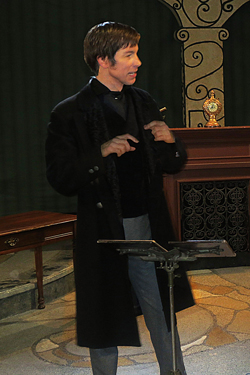
It would be easy for us to think that the inspiration for The Chimes was the Henry Wadsworth Longfellow poem/hymn "I Heard the Bells On Christmas Day." In fact, it was forty years earlier that Charles Dickens visited Italy and, hearing the cathedral bells of Genoa peal on New Year's Day, immediately decided to make them the focus of his follow-up to his successful Christmas Carol. (Modern audiences may also find themselves reminded of the popular film It's a Wonderful Life.)
Our fable proposes a messenger-for-hire named Trotty, whose occupation has convinced him that the world is a sorry mess of corruption and injustice and its population undeserving of its meager bounties. Even the happy news that his daughter is to marry the man she loves is eclipsed by the dismal pronouncements of Trotty's customers, and his futile efforts to aid a homeless man and child only drive him to greater despair. On New Year's Eve, however, some compulsion draws him to the local church's bell-tower, where goblins inform him that he has died, leaving his loved ones only gloomy prognostications as his legacy. They then proceed to show him a picture of a future bereft of his presence. Confronted with woe even greater than his efforts have forestalled, Trotty repents of his pessimism, declaring his duty to be the preservation of hope for a better future through intervention in the present, whereupon he awakens on New Year's Day a changed man.
Nick Sandys began his adaptation of this oft-ignored tale—one of ten in Dickens' holiday canon—as an alternative to what the British-born actor-director saw as a plethora of Christmas Carols. "Dickens is popular in England, but Carol's ubiquity within the American theatrical tradition is a curiosity. Dickens, himself, included excerpts from Chimes on his first North American reading tour—albeit excising most of the social protest."
The page-to-stage Chimes is also a solo turn, though Sandys admits that its first incarnation (at Live Bait, in 1993) was conceived as a staged reading for eight voices. Does he anticipate again expanding it for ensemble performance? "At some future time, I would like to revisit the possibilities of remounting the multiple-voice text, but right now, the one-man version means that it travels easily and thus can be featured at outside events as sort of an adult outreach."
Sandys denies basing his choice in the story's secularism, however. " The Chimes has all the elements that render Dickens accessable to a broad range of audiences—supernatural intervention (by goblins this time, rather than ghosts) with an educational agenda, insights into the lives of the people surrounding the protagonist, and a resolution delivering our hero a second chance. I didn't really think of the story as a New Year's tale until I began to adapt it, but looking at it now, the wider thematic scope lent by the occasion seems to give it an extra dimension."
The Chimes plays at the Greenhouse through December 31.
Mary Shen Barnidge
Contributing Writer

 Follow Us On Twitter
Follow Us On Twitter